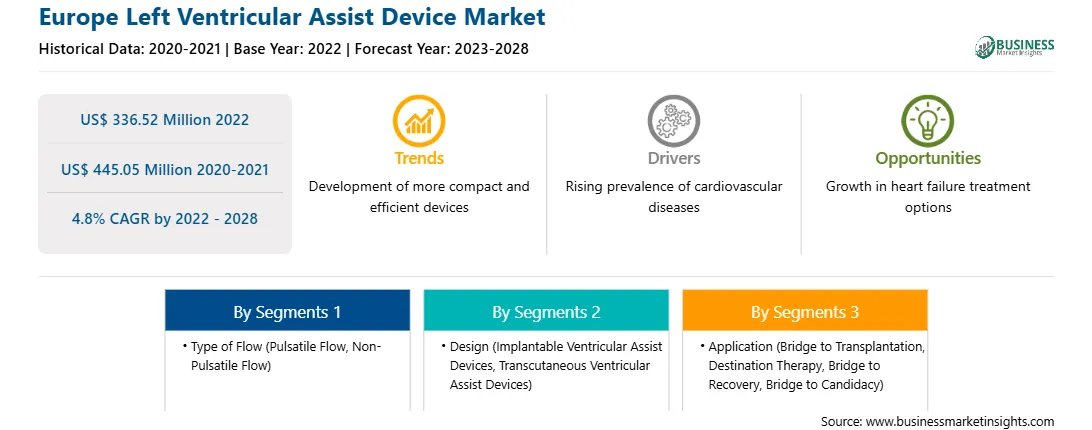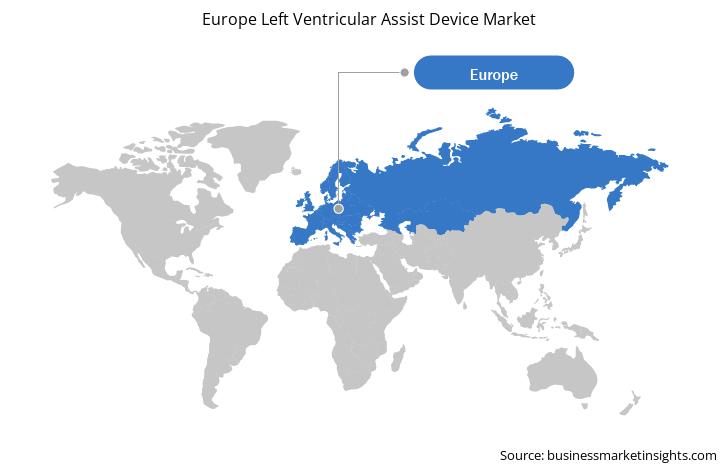The increased incidence of complications and adverse events associated with LVAD encouraged manufacturers to develop innovative technologies and integrate new technologies into the devices. In several cases, patients with LVAD devices experience right ventricle failure leading to blood buildup in veins and swelling. To reduce the failure, manufacturers have integrated artificial intelligence (AI) to monitor the right ventricle with LVAD. Therefore, any change in the right ventricle activity and function will be reported to the healthcare professional, reducing the chances of right ventricle failure and complications.
Furthermore, the increased use of machine learning (ML) for developing risk scores for heart failure mortality provides an edge over conventional methods. Additionally, telemetry data analysis from wearable devices helps predict heart failure hospitalizations. Machine learning algorithms are used to access tricuspid annulus excursion on 2D and 3D echocardiography, which helps in the assessment of right ventricle function. Moreover, machine learning-based algorithms use 3D echocardiographic images to study the right ventricle volume and ejection fraction, providing exact data and efficient automated analysis of heart function.
Therefore, the use of artificial intelligence and machine learning algorithms helps develop a risk prediction model based on right ventricle functions in end-stage heart failure patients with LVAD. The risk stratification for right ventricle failure is one of the significant factors that help determine the patients’ survival. Therefore, the use of artificial intelligence and machine learning in LVAD is likely to emerge as a key trend in the left ventricle assist devices (LVAD) market during the forecast period.
According to the UK Parliament’s data, approximately one-fifth of the total UK population was aged 65 and above in 2019. Moreover, the number of people in this age group increased by 23% from 2009 to 2019, while the total UK population increased by only 7% during the same period. People aged 65 or above are highly prone to cardiovascular diseases and heart failure. With the increasing prevalence of heart failure, the waiting list for heart transplantation is long in the UK. According to a study by the British Heart Foundation, ~300 people were living with LVAD in the UK in 2019, while only ~100 people were living with LVAD in 2012. According to the data provided by the British Geriatrics Society, in 2020, ~1 million people in the UK were living with heart failure, and ~5% of the people admitted to hospitals for emergencies were suffering from heart failure. In 2020, ~2% of the total National Health Service (NHS) expenditure is spent on treatment of heart failure. A surge in the prevalence of heart failure is propelling the growth of the LVAD market in the UK.
Strategic insights for the Europe Left Ventricular Assist Device provides data-driven analysis of the industry landscape, including current trends, key players, and regional nuances. These insights offer actionable recommendations, enabling readers to differentiate themselves from competitors by identifying untapped segments or developing unique value propositions. Leveraging data analytics, these insights help industry players anticipate the market shifts, whether investors, manufacturers, or other stakeholders. A future-oriented perspective is essential, helping stakeholders anticipate market shifts and position themselves for long-term success in this dynamic region. Ultimately, effective strategic insights empower readers to make informed decisions that drive profitability and achieve their business objectives within the market.

| Report Attribute | Details |
|---|---|
| Market size in 2022 | US$ 336.52 Million |
| Market Size by 2028 | US$ 445.05 Million |
| Global CAGR (2022 - 2028) | 4.8% |
| Historical Data | 2020-2021 |
| Forecast period | 2023-2028 |
| Segments Covered |
By Type of Flow
|
| Regions and Countries Covered | Europe
|
| Market leaders and key company profiles |
The geographic scope of the Europe Left Ventricular Assist Device refers to the specific areas in which a business operates and competes. Understanding local distinctions, such as diverse consumer preferences (e.g., demand for specific plug types or battery backup durations), varying economic conditions, and regulatory environments, is crucial for tailoring strategies to specific markets. Businesses can expand their reach by identifying underserved areas or adapting their offerings to meet local demands. A clear market focus allows for more effective resource allocation, targeted marketing campaigns, and better positioning against local competitors, ultimately driving growth in those targeted areas.

Europe Left Ventricular Assist Device Market Segmentation
The Europe left ventricular assist device market is segmented into type of flow, design, application, and country.
Based on type of flow, the Europe left ventricular assist device market is bifurcated into pulsatile flow and non-pulsatile flow. In 2022, the non-pulsatile flow segment registered a larger share in the Europe left ventricular assist device market.
Based on design, the Europe left ventricular assist device market is bifurcated into implantable ventricular assist devices and transcutaneous ventricular assist devices. In 2022, the implantable ventricular assist devices segment registered a larger share in the Europe left ventricular assist device market.
Based on application, the Europe left ventricular assist device market is segmented into Bridge to transplantation, destination therapy, bridge to recovery, and bridge to candidacy. In 2022, the destination therapy segment registered the largest share in the Europe left ventricular assist device market.
Based on country, the Europe left ventricular assist device market is segmented into the UK, Germany, France, Italy, Spain, and the Rest of Europe. In 2022, the UK registered the largest share in the Europe left ventricular assist device market.
Abbott Laboratories, Medtronic Plc, Evaheart Inc., and CorWave SA are some of the leading companies operating in the Europe left ventricular assist device market.
The Europe Left Ventricular Assist Device Market is valued at US$ 336.52 Million in 2022, it is projected to reach US$ 445.05 Million by 2028.
As per our report Europe Left Ventricular Assist Device Market, the market size is valued at US$ 336.52 Million in 2022, projecting it to reach US$ 445.05 Million by 2028. This translates to a CAGR of approximately 4.8% during the forecast period.
The Europe Left Ventricular Assist Device Market report typically cover these key segments-
The historic period, base year, and forecast period can vary slightly depending on the specific market research report. However, for the Europe Left Ventricular Assist Device Market report:
The Europe Left Ventricular Assist Device Market is populated by several key players, each contributing to its growth and innovation. Some of the major players include:
The Europe Left Ventricular Assist Device Market report is valuable for diverse stakeholders, including:
Essentially, anyone involved in or considering involvement in the Europe Left Ventricular Assist Device Market value chain can benefit from the information contained in a comprehensive market report.